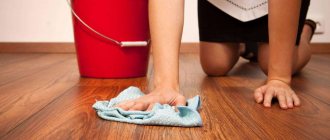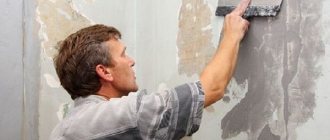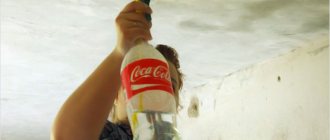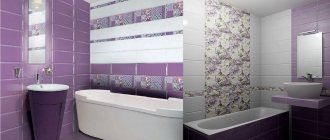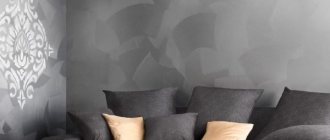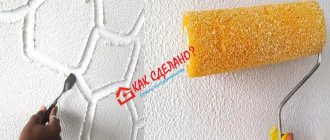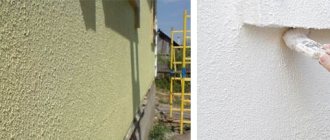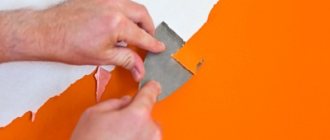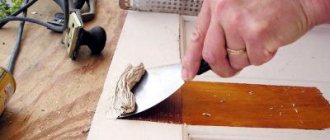Paint on a bathroom wall can be a serious obstacle when carrying out renovation work. It is difficult to get rid of it, since it was most often applied to concrete.
The process of removing it is associated with dust, noise and an impressive amount of time. However, not all methods of removing old coating are so complicated.
Knowing the basic methods of removing paint, you can choose the best option for yourself. We'll tell you how to remove paint from bathroom walls in this article.
When to shoot
In years past, painting walls has been popular in kitchens and bathrooms. In modern times, beautiful tile patterns have been included in the design, which cannot be laid without clearing the surface of the old paint.
But there are situations when this is not necessary, for example, if the wall will be covered with plasterboard in the future. In other cases, the coating is removed, since it does not promote adhesion (cohesion) of the material with adhesives, plasters and other building compounds.
Main mistakes
In order not to harm your own health and not damage the wall, you need to familiarize yourself with the most common mistakes that inexperienced repairmen make :
Working with caustic substances without a respirator and gloves.
The bathroom is a small room with poor ventilation. In it, caustic vapors spread very quickly. Inhaling them can cause serious poisoning.- Excessive pressure on the wall. If you overdo it with mechanical methods of removing paint, this can lead to destruction of the concrete base. It is difficult to straighten a heavily damaged wall.
- Removing paint from the area of electrical switches without turning them off. The room must be de-energized during work. One careless movement is enough to get an electric shock.
It is better to remove the bathtub and other plumbing fixtures from the room during the work.
Choosing a method for removing paint
When choosing a wall paint remover, consider the following criteria.
- Type of dye - oil, acrylic or water-based. If the type is unknown to you, then you will need to select a removal method by experimenting on a small area. You need to start with the least labor-intensive methods. It is also important to know the number of layers and the strength of their adhesion to the wall.
- The material of the painted surface is concrete, wood, metal or drywall. For example, oil paint is the most difficult to remove from unplastered concrete.
- Further work includes painting, tiling, etc.
- The budget for the event is for the purchase of special tools and equipment.
- Possibility of ventilation.
What you will need
The choice is also influenced by the availability of the necessary tools. The following devices can be used:
- brush;
- personal protective equipment (respirator, goggles, rubber gloves, etc.);
- ax for notching;
- construction hair dryer;
- chisel;
- putty knife;
- roller;
- iron scraper;
- electric drill;
- Bulgarian;
- chemical agent for removing paint from walls;
- water.
Important! Before the procedure, cover the furniture and floor with film to prevent them from becoming covered with construction debris.
Three main options for removing oil paint
It is most problematic to remove oil dye from unplastered surfaces. But it can be done. Today there are three main methods, which are characterized by labor intensity and duration of the process.
Use of chemicals
Removing paint from walls using chemical mixtures is carried out according to the instructions supplied with the product. Prepare the solution and spread it over the surface using a brush or roller.
Advice! Movements must be performed in one direction only.
Wait until the dye softens. Remove it along with the wash using one of the devices to choose from:
- putty knife;
- scraper;
- brush with metal bristles.
The advantage of the option with paint remover: speed of cleaning.
Flaws:
- a specific smell that does not disappear for a long time;
- in addition to durability, it is characterized by a high content of toxins;
- upon contact with skin causes chemical burns;
- considerable cost;
- requires special disposal.
Important! If the surface has been painted several times, the product will not remove the coating the first time. It will not be possible to quickly remove paint from the walls, since the application of the chemical composition will also need to be done repeatedly.
Follow safety rules during work - ventilate the room, use personal protective equipment. Allergy sufferers, children, pets and pregnant women are prohibited from attending. Make sure that the composition does not come into contact with the skin. Wear protective clothing.
It is possible to clean walls from old paint using other methods. If you need to work on a plank floor, wet the surface with water and then cover it with soda ash. Make the layer thick so that it covers the entire area. Wet the burlap and cover the floor. Wait a day, constantly keeping the material moist. After the expiration date, remove the layer using a spatula. This is done easily, as it will swell from moisture.
The next method is a mixture of potassium carbonate and lime. The first component can be replaced with soda ash. You will need 400 g of it. Mix this amount in 1.2 kg of quicklime and apply to the surface. Wait 12 hours before removing paint from the wall.
Another way is to use liquid glass. Lubricate the coating, let it dry and remove the silicate film along with the peeling paint. The procedure may need to be repeated several times.
Chemical cleaning is also suitable for the following types of dyes:
- glyphthalic;
- pentaphthalic;
- polymer;
- nitro.
For small areas, you can use solvents.
Heat treatment
A hair dryer will help in this situation. Heat the surface until the dye softens. Next, you need to remove the paint from the wall using a spatula or any other scraper. If a special hair dryer is not available, do not use a regular one. It is better to heat the coating with an iron, after covering it with a large sheet of foil. At the end of the work, wash the wall, clean up minor defects and wipe with a swab dipped in solvent.
This method is suitable for those places where there should be no vibration and shock (where there are window frames, glazed doors, etc.). This method is not used where wiring is located, or where there are decorative elements that are damaged by high temperatures (for example, plastic).
The main disadvantage of the thermal method of cleaning walls from paint is the evaporation of toxic substances when it is heated, as well as the specific odor that accompanies this. Safety measures include working exclusively in ventilated areas. In addition, you need to use personal respiratory protection.
Types of mechanical methods for removing paint
This option is suitable for anyone who is worried about toxic emissions from other types of wall treatments when removing old paint. To do this, use a notch with an ax. The process has the following characteristics:
- no harmfulness;
- cheapness;
- not dangerous;
- duration of work;
- labor intensity.
The sequence of actions is as follows:
- make notches using a tool;
- spray the painted surface with water;
- wait for it to be absorbed;
- Rip off the old paint from the wall with an axe.
Important! If you choose the right blade angle, it will increase the efficiency of the work, as well as the speed of its completion.
This option is suitable for difficult to ventilate rooms. It is used in small areas, since a lot of physical force is used for work. It is often used where tiles will be laid in the future, since the resulting unevenness contributes to better adhesion of the materials.
Interesting! The surface is sprayed with water to reduce the amount of dust generated in the process.
You can peel off the paint from the walls if it has already begun to peel off due to age with a spatula or chisel. This is also a labor-intensive method, but it is clean. It is suitable for wooden surfaces, as well as places where sockets, baseboards, pipes, etc. are placed. In the process, you need to have sandpaper, which will be needed to sharpen the tool.
Electromechanical method
This method is suitable for removing old paint from concrete walls as it is highly efficient, making the job easier. To do this, use a grinder with a wide grinding wheel with an abrasiveness of at least 40, but be prepared for the fact that a lot of dust will be generated in the process. After a minute of processing, you need to wait 20 minutes for the dust to settle. Now on sale you can find models equipped with a vacuum cleaner, which makes the procedure easier and cleaner.
Also used for work is an attachment created like a brush made from cutting steel wire.
You can also take a hammer drill with special attachments. There are two options for removing paint from walls in the bathroom and other rooms. In the first case, chains are used as attachments. This method is suitable for any surface - wood, metal or concrete . It is characterized by efficiency and low cost. Use the same method to remove rust.
To carry out the procedure, two types of chains are taken:
- paint remover;
- 13-link configuration.
Features of this paint stripping tool:
- the thickness of the link must be at least 5 mm;
- the central link rotates 6 links on each side;
- the base is a 6 mm bolt;
- the drill should rotate to the left;
- After putting on the chain, tighten the nut firmly to maintain fit during operation.
If the end link flies off on one side, then the one on the opposite side will also need to be removed so that there is balance. Work continues until at least three links remain with each of them.
Important! When cleaning, the paint from the walls will fly off in pieces, so you will need to protect your body from mechanical impact.
In the second method of working with a hammer drill, brick crowns are used as an attachment.
The electromechanical method is rarely used on painted wood, since the tool can easily damage the surface. To work you need to have special skills.
Washing technology
When the choice of a suitable product has been made, it’s time to figure out the correct technology for its application:
- For the most effective and deep penetration of the reagent into the layer of old paint, the surface must be free of dust and other contaminants. You can wash the walls using household chemicals, and then scrub them with a stiff brush or coarse sandpaper;
- Now we apply the chemical composition itself. This should be done using a wide brush or roller. Do not wet them too much so that the product flows or drips onto the floor. It is better to direct movements in one direction;
- So that the reagent does not evaporate from the surface so quickly and has time to have the proper effect on it, you can cover the surface with a film. This, of course, must be done with gloves;
- After the recommended time, remove the film and remove the paint;
- At the end, you need to wash off the remaining reagent from the wall and neutralize its effect. The manufacturer will definitely provide recommendations on this matter.
That's all, your walls are ready for further transformation. If one of the above methods does not give full effect, try combining it with other methods. By and large, they are all suitable for removing any type of paint.
The article was written for the site.
Tags:Preparation for room renovation, Enamels and paints
Removing water-based dye
In this situation, you can quickly remove the paint from the wall, since most of them are not waterproof. To do this, wet the roller in warm water and treat the surface. You can also use a soap solution. Leave it damp for 10 - 15 minutes, then clean the area with a spatula. The procedure may need to be repeated, and even use a wire brush. If this does not help, then use the methods listed for eliminating oil dye.
Advice! Treat small areas to monitor moisture levels.
Briefly about the main thing
To prepare walls during repairs, you can use various methods - chemical, thermal or mechanical.
Chemical involves applying a solvent or remover, while thermal paint is heated with a hairdryer and then scraped off with a spatula.
With mechanical finishing, the finishing coating is knocked down with an ax or cleaned off with a drill with an attachment.
Acrylic paint is removed with a metal scraper for washing dishes, and water-based paint is thoroughly soaked with water and scraped off with a spatula.
Ratings 0
Removing acrylic paint
A wire brush and coarse sandpaper are suitable for removing acrylic paint. Wear rubber gloves to protect your hands during the process. If the paint you buy is of high quality, it will be more difficult to remove. If the simple method doesn't work, use the oil dye removal instructions.
Advice! If the surface coated with acrylic paint is planned to be painted with the same material in the future, then the previous layer does not need to be removed if it has retained its smoothness.
Is it worth doing this yourself?
Let's start with the fact that, theoretically, it is not necessary to remove old paint at all - drywall and suspended ceilings, as well as plastic panels, allow you to install new finishes on top of an unprepared surface, that is, you do not have to remove anything at all. It’s another matter if preference was given to more classic options, such as tiles or the same paint - then the previous layer must be removed.
Whether to take on the work yourself or entrust it to professionals, everyone decides for themselves. Everything depends only on the needs and wishes of the owner, as well as his willingness to work using one of the methods presented in the selection.
What not to do
It is not recommended to use the following products to remove paint:
- the thermal method using open fire is too fire hazardous;
- chemical remover - not used in unventilated areas.
Regardless of the method you choose to remove paint from walls, do not forget to use personal protective equipment. In any process you will be exposed to the following negative factors:
- dust;
- toxic substances;
- small particles of flying coating.
The most important thing to protect is the respiratory and visual organs.
